Genesis of Megacrystalline Uraninite: A Case Study of the Haita Area of the Western Margin of the Yangtze Block, China
Abstract
:1. Introduction
2. Geological Background
2.1. Regional Geological Background
2.2. Geological Background of the Study Area
2.3. Geology of Uranium Occurrences
3. Analytical Methods
4. Geochemical Composition of Uraninite
4.1. Major Element Compositions
4.2. Trace Element Compositions
5. Discussion
5.1. Comparison of Genetic Type
5.2. Relationship between the Felsic and Quartz Veins
5.3. Discussion on Genesis of Uraninite
6. Conclusions
Supplementary Materials
Author Contributions
Funding
Institutional Review Board Statement
Informed Consent Statement
Data Availability Statement
Acknowledgments
Conflicts of Interest
References
- Dahlkamp, F.J. Uranium Ore Deposits; Springer: New York, NY, USA, 1993; p. 450. [Google Scholar]
- Cuney, M. The extreme diversity of uranium deposits. Miner. Deposita 2008, 44, 3–9. [Google Scholar] [CrossRef]
- Cuney, M. Uranium and Thorium: The Extreme Diversity of the Resources of the World’s Energy Minerals; Springer: New York, NY, USA, 2012; p. 39. [Google Scholar]
- IAEA. World Distribution of Uranium Deposits (UDEPO) with Uranium Deposit Classification: IAEA-TECDOC-1843; International Atomic Energy Agency: Vienna, Swiss, 2016; pp. 1–3. [Google Scholar]
- IMA. List of Minerals. In Commission on New Minerals, Nomenclature and Classification; International Mineralogical Association: Paris, France, 2021; p. 219. [Google Scholar]
- Shannon, R.D. Revised effective ionic radii and systematic studies of interatomic distances in halides and chalcogenides. Acta Crystallogr. Sect. A Cryst. Phys. Diffr. Theor. Gen. Crystallogr. 1976, 32, 751–767. [Google Scholar] [CrossRef]
- Frimmel, H.E.; Schedel, S.; Brätz, H. Uraninite chemistry as forensic tool for provenance analysis. Appl. Geochem. 2014, 48, 104–121. [Google Scholar] [CrossRef]
- Janeczek, J.; Ewing, R. Structural formula of uraninite. J. Nucl. Mater. 1992, 190, 128–132. [Google Scholar] [CrossRef]
- Grandstaff, D.E. A kinetic study of the dissolution of uraninite. Econ. Geol. 1976, 71, 1493–1506. [Google Scholar] [CrossRef]
- Reimer, T.O. The Late-Archean Dominion conglomerates (South Africa): New aspects of their derivation and their relationship with those of the Witwatersrand. Neues Jahrb. Geol. Pa. 1987, 158, 13–46. [Google Scholar]
- Bea, F.; Mitchell, J.N.; Scoates, J.S.; Frost, C.D.; Kolker, A. Residence of REE, Y, Th and U in Granites and Crustal Protoliths; Implications for the Chemistry of Crustal Melts. J. Pet. 1996, 37, 521–552. [Google Scholar] [CrossRef]
- Fryer, B.J.; Taylor, R.P. Rare-earth element distributions in uraninites: Implications for ore genesis. Chem. Geol. 1987, 63, 101–108. [Google Scholar] [CrossRef]
- Pagel, M.; Pinte, G.; Rotach-Toulhoat, N. The rare earth elements in natural uranium oxides. In Uranium Mineralization-New Aspects on Geology, Mineralogy, Geochemistry, and Exploration Methods; International Atomic Energy Agency: Vienna, Austria, 1987; pp. 1–320. [Google Scholar]
- Maas, R.; McCulloch, M. A search for fossil nuclear reactors in the Alligator River Uranium Field, Australia: Constraints from Sm, Gd and Nd isotopic studies. Chem. Geol. 1990, 88, 301–315. [Google Scholar] [CrossRef]
- Hidaka, H.; Holliger, P.; Shimizu, H.; Masuda, A. Lanthanide tetrad effect observed in the Oklo and ordinary uraninites and its implication for their forming processes. Geochem. J. 1992, 26, 337–346. [Google Scholar] [CrossRef]
- Hidaka, H.; Gauthier-Lafaye, F. Neutron capture effects on Sm and Gd isotopes in uraninites. Geochim. et Cosmochim. Acta 2001, 65, 941–949. [Google Scholar] [CrossRef]
- Mercadier, J.; Cuney, M.; Lach, P.; Boiron, M.-C.; Bonhoure, J.; Richard, A.; Leisen, M.; Kister, P. Origin of uranium deposits revealed by their rare earth element signature. Terra Nova 2011, 23, 264–269. [Google Scholar] [CrossRef]
- Hazen, R.M.; Ewing, R.C.; Sverjensky, D.A. Evolution of uranium and thorium minerals. Am. Miner. 2009, 94, 1293–1311. [Google Scholar] [CrossRef]
- Zhang, C.J.; Chen, Y.L.; Li, J.C.; Xu, Z.Q.; Yao, J. The discovery of coarse-grained uraninite in Kangdian Axis and its geological significance. Geol. Bull. China 2015, 34, 2219–2226, (In Chinese with English Abstract). [Google Scholar]
- Wang, F.G.; Sun, Y.; Yao, J.; Ye, J.L. Study on characteristics of gaint grain uraninite in Haita area of Miyi County, Sichuan. World Nuclear Geosci. 2017, 34, 187–193, (In Chinese with English Abstract). [Google Scholar]
- Wang, F.G.; Yao, J. A new consideration on the genesis of uranium mineralization in Mouding,Yunnan: A new mineralization type related to albitite. Geol. Rev. 2020, 66, 739–754, (In Chinese with English Abstract). [Google Scholar]
- Chang, D. Geological and Geochemical Characteristics of Migmatite Type Uranium Deposit in the Haita area, Miyi Town, Sichuan Province. Master’s Thesis, Chengdu University of Technology, Chengdu, China, 2016. (In Chinese with English Abstract). [Google Scholar]
- Liu, K.P. Mineralization Physical and Chemical Conditions of Uranium Deposit in Haita area, Miyi County, Sichuan Province. Master’s Thesis, Chengdu University of Technology, Chengdu, China, 2017. (In Chinese with English Abstract). [Google Scholar]
- Guo, R.; Chen, Y.L.; Liu, K.P.; Zheng, Y.W.; Hu, Y. Characteristics of fluid inclusions in quartz of the haita migmatite type uranium deposit in Miyi county, Sichuan province, China. Ac. Mineral. Sin. 2020, 40, 137–148, (In Chinese with English Abstract). [Google Scholar]
- Yin, M.; Xu, Z.; Song, H.; Zhang, C.; Zhang, S.; Tian, J.; Guo, H. Constraints of the geochemical characteristics of apatite on uranium mineralization in a uraninite-rich quartz vein in the Haita area of the Kangdian region, China. Geochem. J. 2021, 55, 301–312. [Google Scholar]
- Sun, Y.; Yao, J.; Li, J.; Sun, Z. Mineralization Characteristics and Origin of Extra Rich Uranium Deposits in Miyi-Yuanmou Area, Middle-South Part of Kangdian Earth’s Axis. Uranium Geol. 2021, 37, 466–475, (In Chinese with English Abstract). [Google Scholar]
- Li, W. Migmatization and Uranium Mineralization in Haita Area of Miyi in Sichuan Province. Uranium Geol. 2018, 34, 346–352, (In Chinese with English Abstract). [Google Scholar]
- Qu, L. Chronology and Geochemical Characteristics of Dingzhen Complex in Miyi District, Sichuan Province. Master’s Thesis, Chengdu University of Technology, Chengdu, China, 2019. (In Chinese with English Abstract). [Google Scholar]
- Zeng, M.; Zhang, D.; Zhang, Z.; Li, T.; Li, C.; Wei, C. Structural controls on the Lala iron-copper deposit of the Kangdian metallogenic province, southwestern China: Tectonic and metallogenic implications. Ore Geol. Rev. 2018, 97, 35–54. [Google Scholar] [CrossRef]
- Song, H.; Chi, G.; Zhang, C.; Xu, D.; Xu, Z.; Fan, G.; Zhang, G. Uranium enrichment in the Lala Cu-Fe deposit, Kangdian region, China: A new case of uranium mineralization associated with an IOCG system. Ore Geol. Rev. 2020, 121, 103463. [Google Scholar] [CrossRef]
- Zhu, L.; Liu, J.; Bagas, L.; Zhai, D.; Meng, G.; Verrall, M. New insights into the genesis of IOCG deposits: From a case study of the Yinachang deposit in SW China. Ore Geol. Rev. 2020, 124, 103664. [Google Scholar] [CrossRef]
- Hu, Z.C.; Zhang, W.; Liu, Y.S.; Gao, S.; Li, M.; Zong, K.Q.; Chen, H.H.; Hu, S.H. “Wave” signal smoothing and mercury removing device for laser ablation quadrupole and multiple collector ICP-MS analysis: Application to lead isotope analysis. Anal. Chem. 2015, 87, 1152–1157. [Google Scholar] [CrossRef] [PubMed]
- Liu, Y.; Hu, Z.; Gao, S.; Günther, D.; Xu, J.; Gao, C.; Chen, H. In situ analysis of major and trace elements of anhydrous minerals by LA-ICP-MS without applying an internal standard. Chem. Geol. 2008, 257, 34–43. [Google Scholar] [CrossRef]
- Cuney, M. Evolution of Uranium Fractionation Processes through Time: Driving the Secular Variation of Uranium Deposit Types. Econ. Geol. 2010, 105, 553–569. [Google Scholar] [CrossRef]
- Anders, E.; Grevesse, N. Abundances of the elements: Meteoritic and solar. Geochim. et Cosmochim. Acta 1989, 53, 197–214. [Google Scholar] [CrossRef]
- Yao, L.Y.; Zhang, B.J. Experimental Geochemistry of the Xiangshan Hydrothermal Uranium Deposit; Atomic Energy Press: Beijing, China, 2014; p. 54. (In Chinese) [Google Scholar]
- Potter, E.G. Michel Cuney and Kurt Kyser: Geology and Geochemistry of Uranium and Thorium Deposits. Miner. Deposita. 2017, 133–134. [Google Scholar] [CrossRef]
- Chen, Y.; Hu, R.; Bi, X.; Luo, J. Genesis of the Guangshigou pegmatite-type uranium deposit in the North Qinling Orogenic Belt, China. Ore Geol. Rev. 2019, 115, 103165. [Google Scholar] [CrossRef]
- Robb, L. Introduction to Ore-Forming Processes; Blackwell Publishing: Malden, MA, USA, 2004; p. 373. [Google Scholar]
- Mercadier, J.; Annesley, I.R.; McKechnie, C.L.; Bogdan, T.S.; Creighton, S. Magmatic and Metamorphic Uraninite Mineralization in the Western Margin of the Trans-Hudson Orogen (Saskatchewan, Canada): A Uranium Source for Unconformity-Related Uranium Deposits? Econ. Geol. 2013, 108, 1037–1065. [Google Scholar] [CrossRef]
- Kukkonen, I.; Lauri, L. Modelling the thermal evolution of a collisional Precambrian orogen: High heat production migmatitic granites of southern Finland. Precambrian Res. 2009, 168, 233–246. [Google Scholar] [CrossRef]
- Wang, R.C.; Fontan, F.; Shijin, X.; Xiaoming, C.; Monchoux, P. Hafnian zircon from the apical part of the Suzhou granite, China. Can. Miner. 1996, 34, 1001–1010. [Google Scholar]
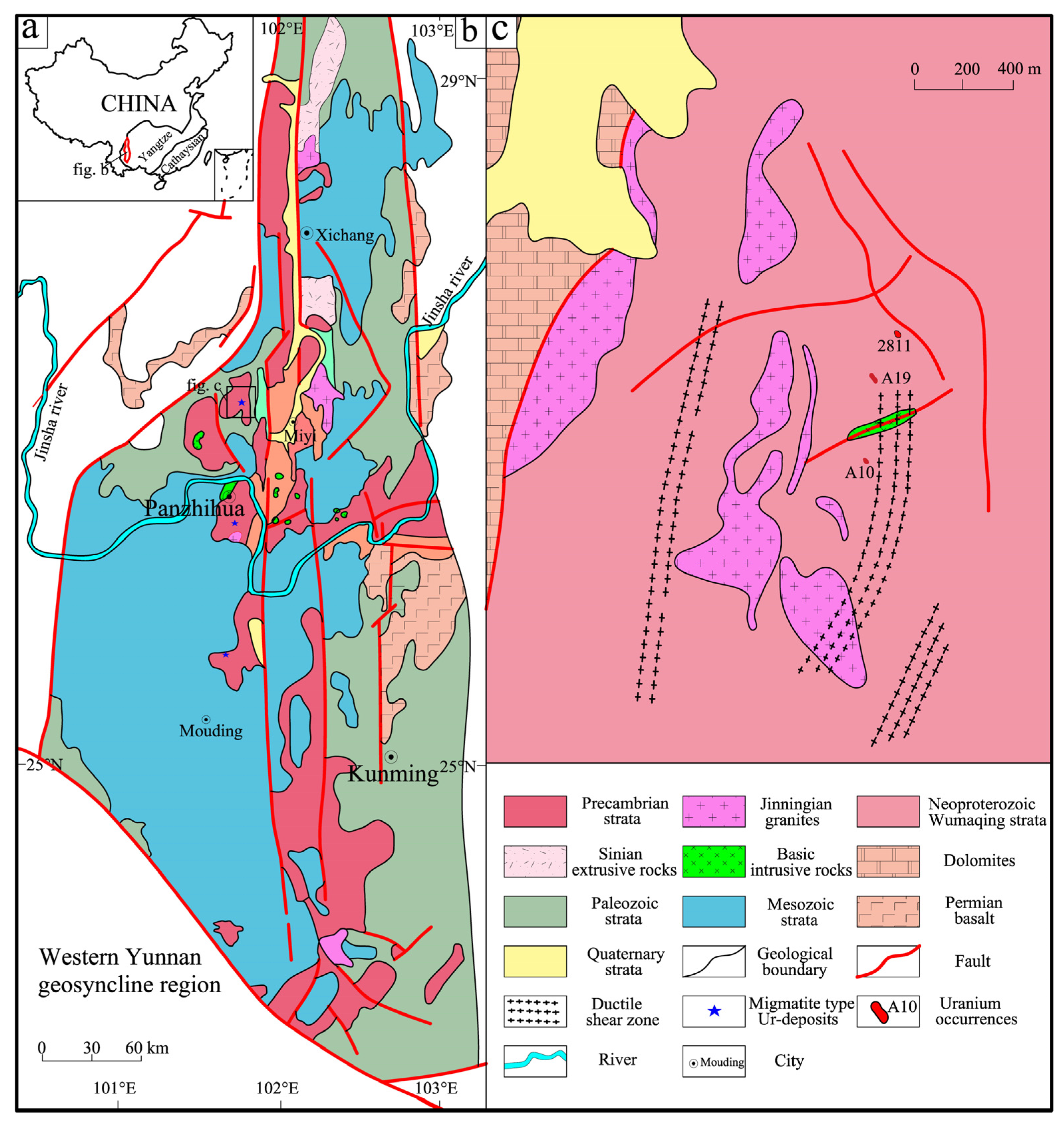
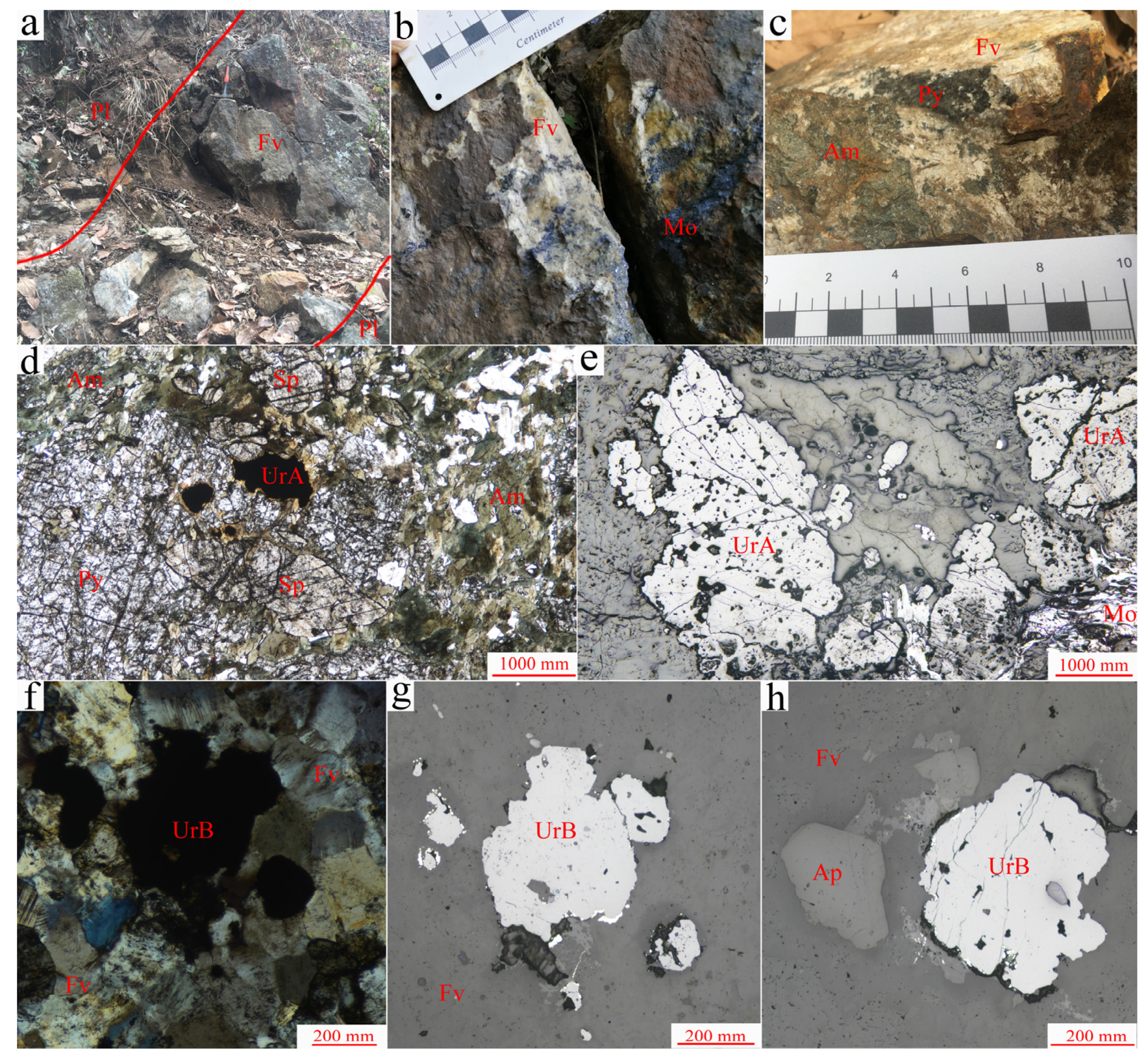
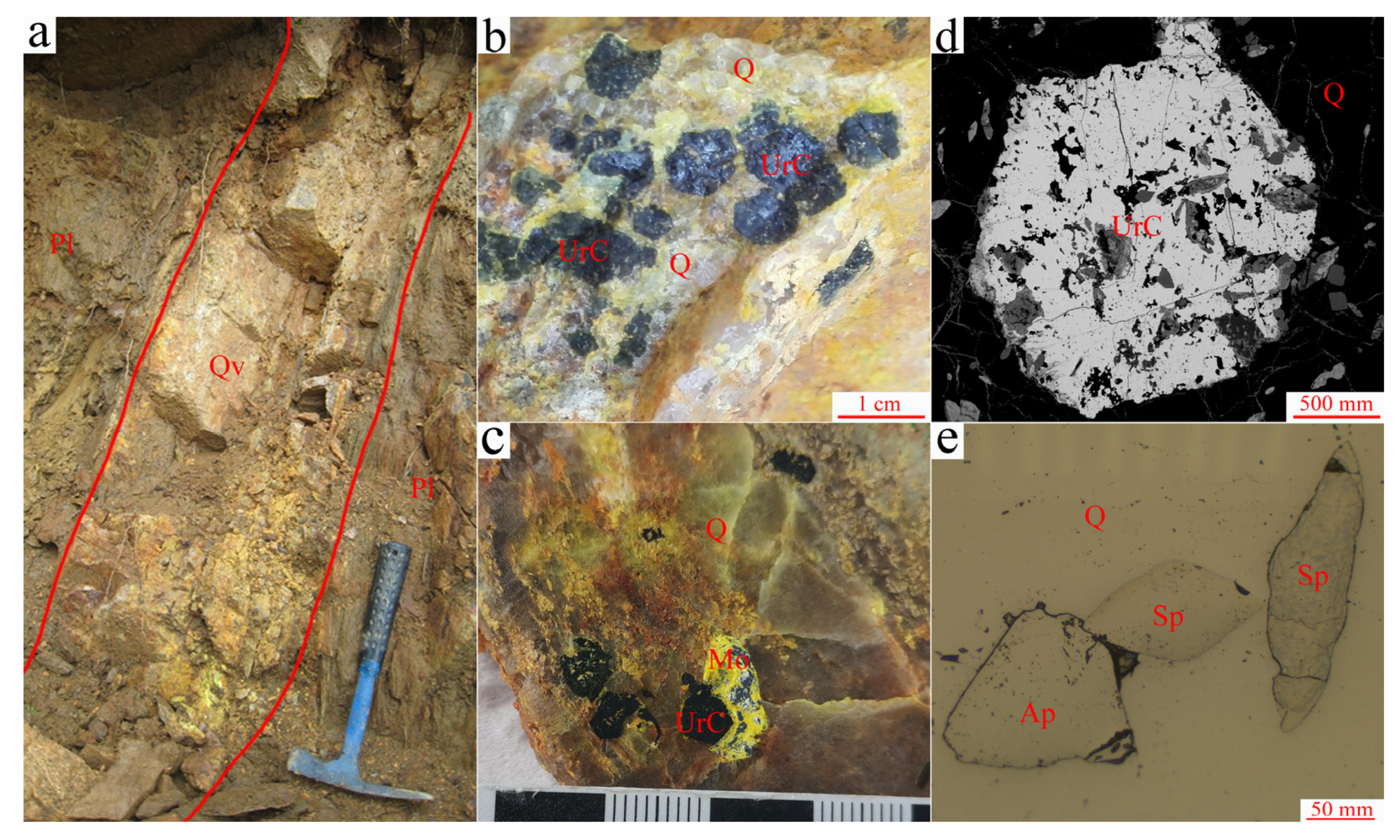
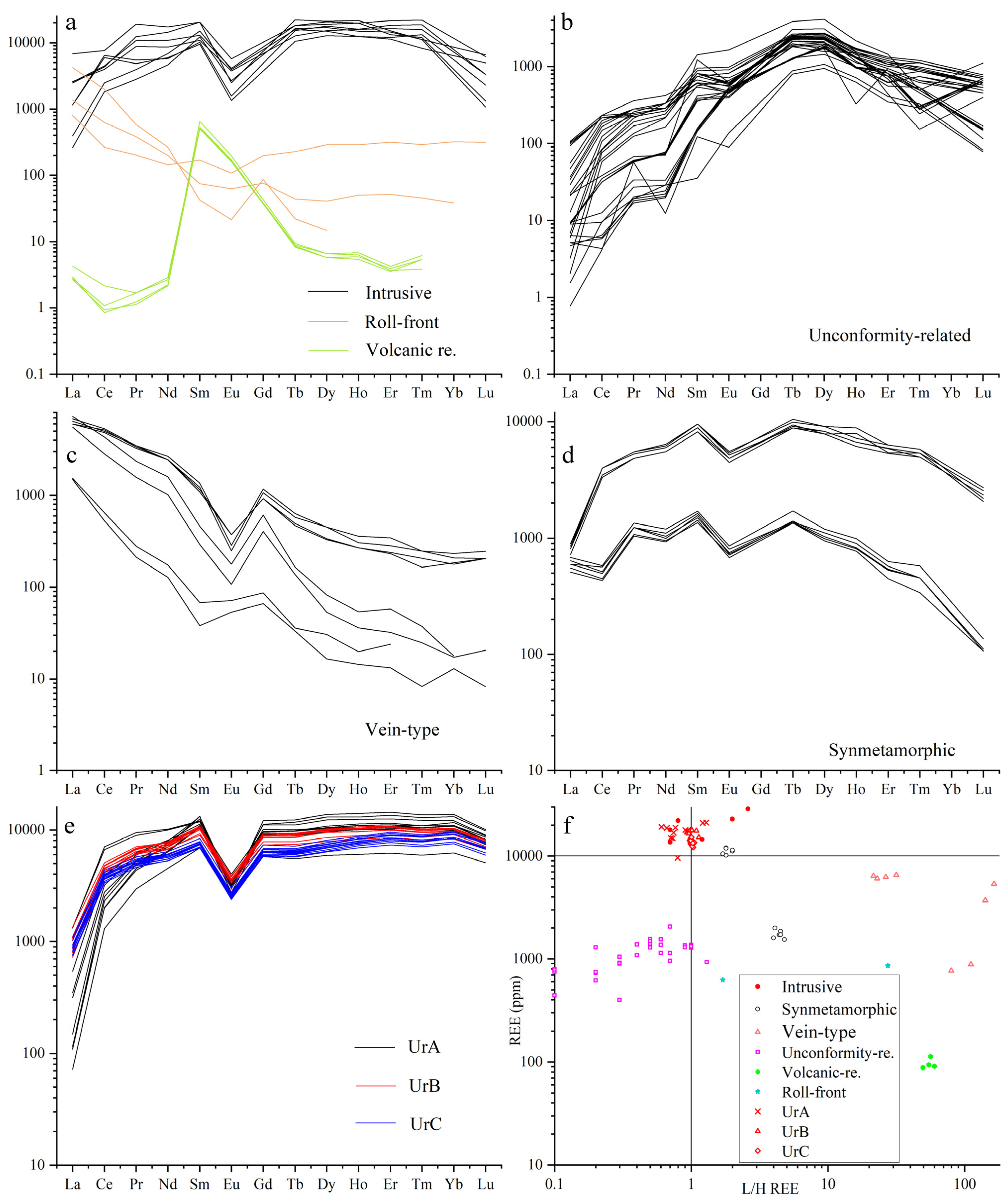
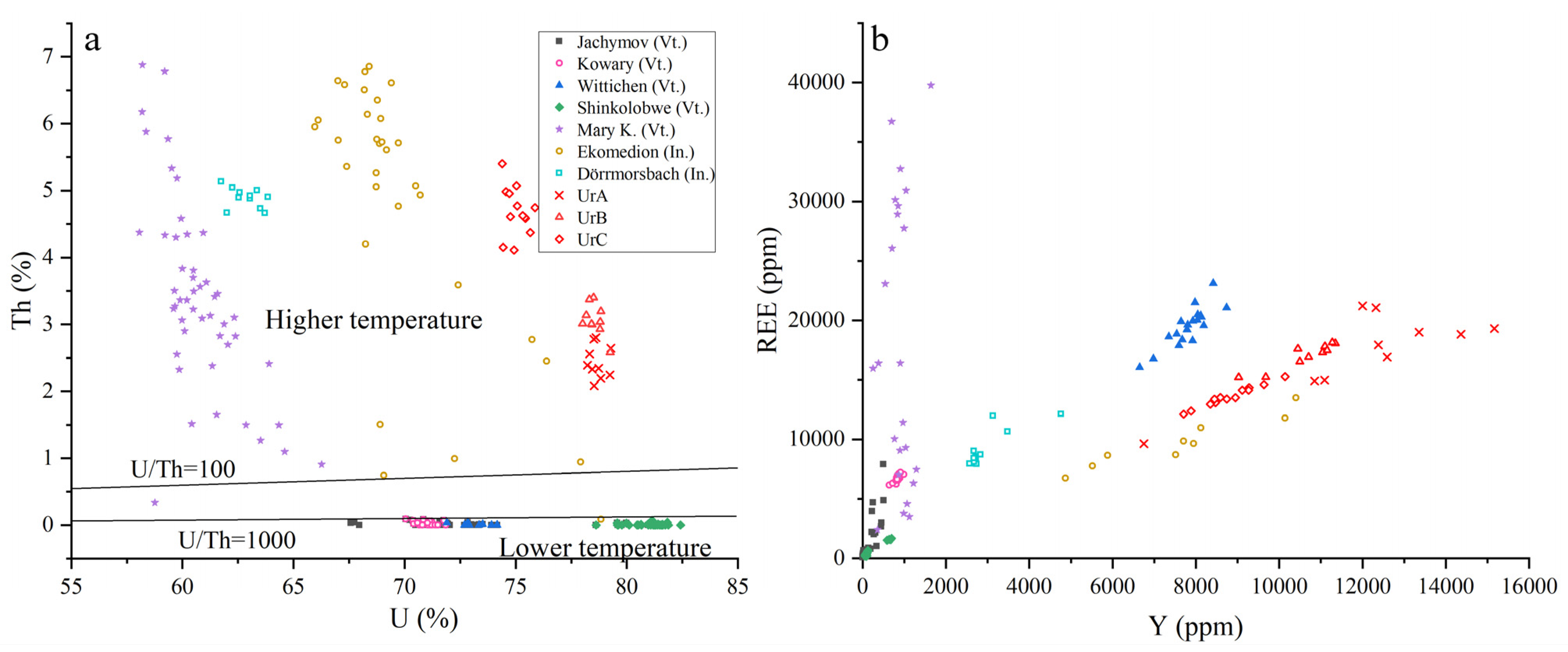
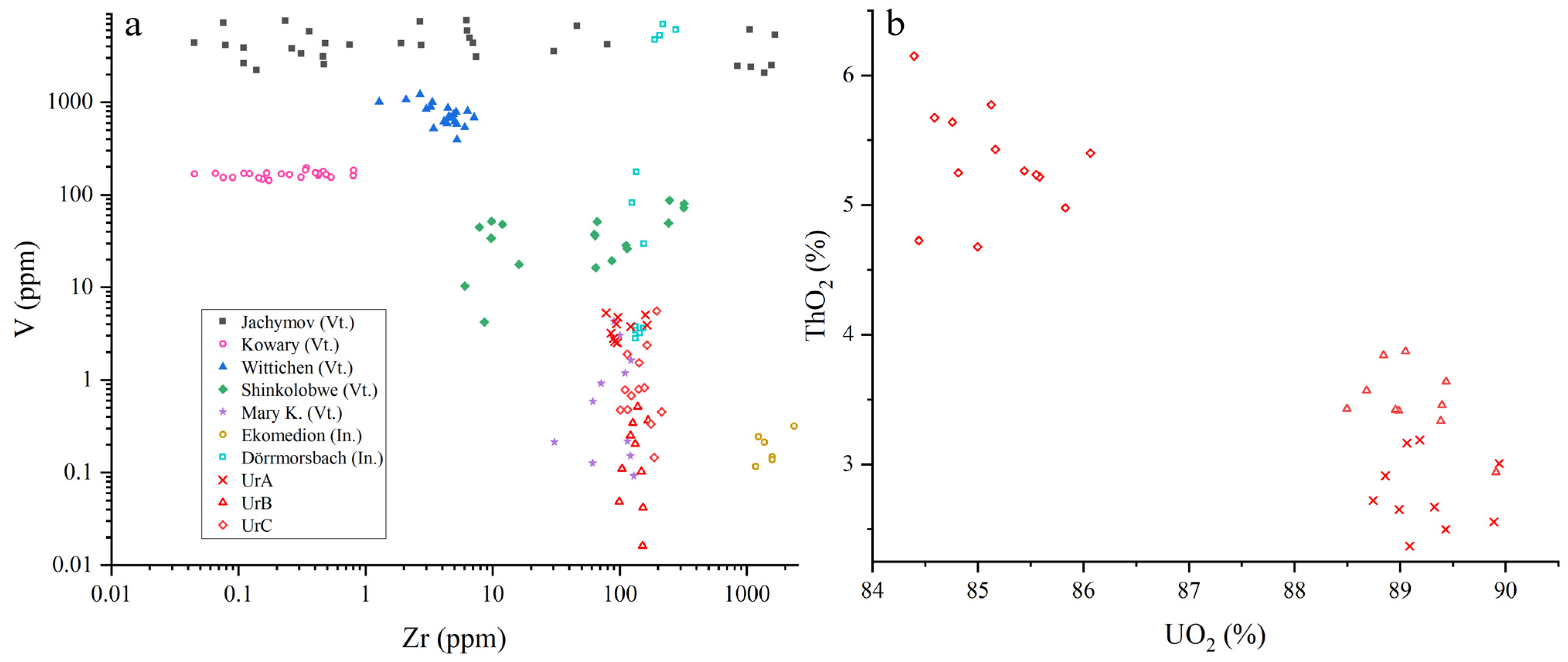
| NO. | Na2O | MgO | Al2O3 | SiO2 | PbO | ThO2 | UO2 | K2O | CaO | TiO2 | FeO | Total |
|---|---|---|---|---|---|---|---|---|---|---|---|---|
| UrA1 | / | 0.013 | / | 0.012 | 2.759 | 2.722 | 88.747 | 0.159 | 0.233 | 0.036 | 0.080 | 94.761 |
| UrA2 | 0.014 | 0.002 | / | 0.02 | 2.877 | 3.164 | 89.067 | 0.161 | 0.272 | 0.030 | / | 95.607 |
| UrA3 | / | / | / | 0.038 | 2.759 | 3.007 | 89.940 | 0.151 | 0.277 | 0.014 | 0.065 | 96.251 |
| UrA4 | 0.009 | / | / | 0.020 | 2.773 | 3.189 | 89.186 | 0.156 | 0.238 | 0.073 | 0.033 | 95.677 |
| UrA5 | 0.022 | / | / | 0.015 | 2.939 | 2.671 | 89.327 | 0.148 | 0.254 | 0.019 | / | 95.395 |
| UrA6 | / | / | / | 0.018 | 2.853 | 2.653 | 88.993 | 0.162 | 0.244 | 0.005 | / | 94.928 |
| UrA7 | 0.006 | 0.006 | / | 0.022 | 2.905 | 2.555 | 89.890 | 0.162 | 0.261 | 0.006 | 0.029 | 95.842 |
| UrA8 | / | / | / | 0.022 | 2.93 | 2.912 | 88.861 | 0.15 | 0.235 | 0.049 | 0.027 | 95.186 |
| UrA9 | 0.002 | / | / | 0.028 | 2.833 | 2.37 | 89.091 | 0.145 | 0.151 | 0.062 | 0.172 | 94.854 |
| UrA10 | 0.005 | 0.01 | / | 0.622 | 2.652 | 2.498 | 89.433 | 0.165 | 0.305 | 0.009 | 0.074 | 95.773 |
| UrB1 | 0.003 | 0.017 | / | 0.022 | 3.056 | 3.427 | 88.496 | 0.159 | 0.331 | 0.039 | / | 95.55 |
| UrB2 | 0.022 | 0.019 | / | 0.019 | 2.976 | 2.938 | 89.909 | 0.161 | 0.354 | 0.083 | / | 96.481 |
| UrB3 | 0.029 | 0.004 | / | 0.035 | 3.096 | 3.335 | 89.387 | 0.139 | 0.316 | 0.037 | / | 96.378 |
| UrB4 | 0.003 | 0.015 | / | 0.035 | 2.945 | 3.455 | 89.397 | 0.174 | 0.377 | 0.001 | / | 96.402 |
| UrB5 | 0.01 | 0.018 | / | 0.053 | 2.818 | 3.412 | 88.985 | 0.169 | 0.354 | 0.022 | / | 95.841 |
| UrB6 | 0.001 | 0.005 | 0.008 | 0.720 | 2.851 | 3.420 | 88.957 | 0.178 | 0.304 | 0.049 | 0.050 | 96.543 |
| UrB7 | / | 0.003 | / | 0.035 | 2.969 | 3.870 | 89.051 | 0.156 | 0.312 | 0.055 | 0.040 | 96.491 |
| UrB8 | 0.026 | 0.011 | / | 0.026 | 2.961 | 3.638 | 89.437 | 0.167 | 0.260 | 0.052 | 0.007 | 96.585 |
| UrB9 | / | 0.023 | / | 0.040 | 2.853 | 3.570 | 88.683 | 0.166 | 0.402 | 0.033 | / | 95.77 |
| UrB10 | / | 0.005 | / | 0.001 | 2.938 | 3.841 | 88.845 | 0.152 | 0.334 | 0.061 | / | 96.177 |
| UrC1 | 0.02 | 0.004 | / | 0.060 | 3.238 | 4.679 | 84.996 | 0.252 | 0.301 | 0.027 | / | 93.577 |
| UrC2 | 0.005 | 0.005 | 0.046 | 0.050 | 2.976 | 4.726 | 84.440 | 0.229 | 0.414 | 0.014 | 0.034 | 92.939 |
| UrC3 | 0.004 | / | / | 0.017 | 2.806 | 5.217 | 85.583 | 0.171 | 0.369 | 0.082 | 0.047 | 94.296 |
| UrC4 | 0.012 | 0.013 | / | 0.070 | 2.938 | 5.233 | 85.552 | 0.211 | 0.350 | 0.059 | / | 94.438 |
| UrC5 | 0.007 | / | / | 0.084 | 2.994 | 6.147 | 84.396 | 0.185 | 0.262 | 0.043 | / | 94.118 |
| UrC6 | / | / | / | 0.095 | 3.031 | 5.672 | 84.589 | 0.227 | 0.313 | 0.026 | 0.018 | 93.971 |
| UrC7 | / | 0.011 | / | 0.095 | 3.063 | 5.639 | 84.758 | 0.191 | 0.482 | 0.015 | 0.064 | 94.318 |
| UrC8 | 0.009 | / | / | 0.045 | 3.224 | 5.261 | 85.439 | 0.205 | 0.279 | 0.028 | 0.010 | 94.500 |
| UrC9 | 0.017 | 0.009 | / | 0.070 | 3.051 | 4.977 | 85.828 | 0.239 | 0.413 | 0.014 | / | 94.618 |
| UrC10 | 0.009 | / | 0.816 | 0.156 | 3.093 | 5.247 | 84.815 | 0.170 | 0.490 | 0.028 | 0.004 | 94.828 |
| UrC11 | 0.013 | / | / | 0.062 | 3.095 | 5.399 | 86.066 | 0.207 | 0.344 | 0.029 | 0.002 | 95.217 |
| UrC12 | 0.006 | 0.016 | 0.032 | 0.061 | 2.857 | 5.429 | 85.165 | 0.205 | 0.463 | 0.044 | / | 94.278 |
| UrC13 | 0.022 | / | / | 0.067 | 2.998 | 5.772 | 85.125 | 0.200 | 0.324 | 0.050 | / | 94.558 |
| NO. | V | Y | Zr | La | Ce | Pr | Nd | Sm | Eu | Gd | Tb | Dy | Ho | Er | Tm | Yb | Lu | Hf |
|---|---|---|---|---|---|---|---|---|---|---|---|---|---|---|---|---|---|---|
| UrA1 | 3.78 | 13,361.93 | 122.12 | 81.36 | 1925.00 | 528.19 | 3599.89 | 1934.33 | 179.20 | 2193.33 | 402.89 | 2987.46 | 694.52 | 1996.01 | 295.10 | 1963.88 | 218.99 | 0.49 |
| UrA2 | 2.53 | 10,847.38 | 95.59 | 25.63 | 1220.05 | 400.80 | 2922.62 | 1566.42 | 154.02 | 1797.94 | 323.29 | 2336.55 | 560.95 | 1607.01 | 230.82 | 1572.98 | 179.02 | 0.33 |
| UrA3 | 2.60 | 6751.92 | 91.55 | 16.89 | 789.21 | 262.58 | 2048.07 | 1012.02 | 139.45 | 1133.26 | 199.62 | 1430.58 | 335.83 | 983.84 | 143.71 | 1007.52 | 123.36 | 0.24 |
| UrA4 | 2.81 | 11,089.65 | 89.55 | 27.15 | 1207.74 | 386.20 | 2866.49 | 1552.08 | 173.87 | 1840.48 | 331.87 | 2383.82 | 557.59 | 1635.11 | 245.47 | 1602.79 | 186.62 | 0.28 |
| UrA5 | 3.20 | 14,364.34 | 85.57 | 35.02 | 1516.55 | 473.73 | 3454.72 | 1838.54 | 177.63 | 2206.75 | 427.65 | 3150.71 | 721.65 | 2143.83 | 310.74 | 2125.68 | 238.39 | 0.41 |
| UrA6 | 3.91 | 12,002.10 | 163.70 | 309.63 | 4238.08 | 844.89 | 4595.41 | 1773.90 | 185.18 | 1898.67 | 353.99 | 2502.39 | 593.11 | 1722.55 | 252.00 | 1757.59 | 197.49 | 0.74 |
| UrA7 | 5.06 | 12,322.04 | 158.78 | 313.81 | 4007.86 | 796.15 | 4512.94 | 1745.23 | 186.17 | 1985.75 | 363.67 | 2543.86 | 608.03 | 1771.57 | 252.68 | 1784.60 | 199.93 | 0.90 |
| UrA8 | 4.03 | 15,164.90 | 94.15 | 26.69 | 1394.84 | 435.16 | 3316.43 | 1942.52 | 164.84 | 2376.74 | 446.57 | 3331.00 | 778.19 | 2287.38 | 329.25 | 2234.14 | 244.75 | 0.44 |
| UrA9 | 5.29 | 12,593.88 | 78.17 | 73.52 | 1672.30 | 464.30 | 3161.90 | 1610.78 | 223.97 | 1899.41 | 356.77 | 2622.23 | 629.77 | 1829.92 | 264.46 | 1894.10 | 215.16 | 0.35 |
| UrA10 | 4.74 | 12379.11 | 96.66 | 127.28 | 2365.67 | 554.79 | 3631.23 | 1656.62 | 182.74 | 1876.94 | 353.86 | 2551.39 | 610.82 | 1767.58 | 263.67 | 1780.48 | 209.41 | 0.53 |
| UrB1 | 0.11 | 11,043.63 | 104.01 | 218.24 | 2510.62 | 551.69 | 3389.77 | 1538.18 | 165.82 | 1805.19 | 333.18 | 2440.02 | 572.39 | 1695.01 | 243.00 | 1660.22 | 189.75 | 0.76 |
| UrB2 | 0.05 | 10,707.16 | 98.91 | 186.84 | 2490.20 | 544.70 | 3246.34 | 1484.17 | 214.83 | 1736.41 | 325.25 | 2396.59 | 565.28 | 1672.90 | 237.94 | 1636.68 | 190.85 | 1.11 |
| UrB3 | 0.10 | 11,348.09 | 147.70 | 259.27 | 2903.89 | 598.11 | 3463.29 | 1571.05 | 200.65 | 1832.11 | 339.11 | 2455.77 | 593.48 | 1718.50 | 246.80 | 1688.02 | 194.60 | 1.49 |
| UrB4 | 0.04 | 11,275.54 | 152.07 | 256.06 | 2887.86 | 609.73 | 3528.70 | 1590.68 | 211.82 | 1818.41 | 332.57 | 2484.59 | 578.35 | 1715.22 | 244.23 | 1686.15 | 197.06 | 1.30 |
| UrB5 | 0.02 | 11,098.00 | 151.00 | 256.66 | 2869.11 | 590.55 | 3487.95 | 1552.83 | 199.32 | 1761.91 | 330.95 | 2448.63 | 572.09 | 1670.86 | 243.02 | 1641.45 | 196.16 | 1.13 |
| UrB6 | 0.51 | 9677.55 | 138.54 | 169.79 | 2331.16 | 506.77 | 3010.07 | 1362.88 | 197.42 | 1532.27 | 281.97 | 2072.87 | 494.05 | 1423.35 | 207.68 | 1474.83 | 172.37 | 0.61 |
| UrB7 | 0.37 | 10,448.28 | 166.89 | 316.64 | 3063.05 | 626.92 | 3462.49 | 1510.98 | 203.16 | 1691.28 | 314.37 | 2302.84 | 538.10 | 1582.47 | 229.24 | 1573.23 | 184.33 | 1.61 |
| UrB8 | 0.20 | 11,149.91 | 132.13 | 248.35 | 2694.28 | 569.86 | 3314.47 | 1534.65 | 216.13 | 1748.59 | 328.83 | 2431.49 | 575.31 | 1686.16 | 245.04 | 1685.18 | 197.76 | 1.12 |
| UrB9 | 0.25 | 9027.06 | 121.18 | 238.15 | 2747.04 | 542.16 | 3057.23 | 1318.82 | 186.48 | 1438.90 | 268.07 | 1903.85 | 457.34 | 1356.20 | 196.54 | 1339.53 | 162.94 | 0.48 |
| UrB10 | 0.34 | 10,494.09 | 126.37 | 201.13 | 2536.71 | 535.48 | 3160.21 | 1484.23 | 192.73 | 1675.22 | 311.15 | 2328.38 | 534.05 | 1592.50 | 231.82 | 1585.89 | 181.08 | 0.79 |
| UrC1 | 1.54 | 7706.36 | 141.83 | 174.92 | 2016.67 | 411.08 | 2406.91 | 1013.54 | 133.53 | 1136.31 | 207.01 | 1537.51 | 383.49 | 1161.50 | 170.34 | 1217.54 | 143.90 | 0.57 |
| UrC2 | 0.47 | 8471.67 | 115.06 | 210.35 | 2164.55 | 432.97 | 2483.67 | 1080.87 | 140.75 | 1228.42 | 223.12 | 1674.94 | 426.69 | 1299.89 | 191.19 | 1360.06 | 163.98 | 0.48 |
| UrC3 | 1.89 | 8948.43 | 114.58 | 193.72 | 2202.64 | 448.04 | 2626.37 | 1110.83 | 145.92 | 1267.47 | 232.85 | 1736.58 | 442.23 | 1334.32 | 196.45 | 1391.19 | 169.38 | 0.57 |
| UrC4 | 0.34 | 8742.42 | 175.81 | 191.47 | 2188.19 | 445.13 | 2574.38 | 1099.36 | 143.38 | 1261.68 | 228.98 | 1718.85 | 436.62 | 1333.54 | 195.69 | 1396.17 | 168.93 | 0.91 |
| UrC5 | 0.78 | 8587.08 | 110.09 | 210.68 | 2394.16 | 464.08 | 2641.75 | 1083.51 | 137.43 | 1230.43 | 220.66 | 1662.78 | 419.98 | 1302.81 | 191.55 | 1385.97 | 166.14 | 0.57 |
| UrC6 | 0.47 | 8347.09 | 101.05 | 209.24 | 2261.53 | 440.70 | 2477.16 | 1028.83 | 133.01 | 1189.24 | 218.17 | 1604.92 | 411.60 | 1261.34 | 187.82 | 1361.88 | 167.02 | 0.42 |
| UrC7 | 0.79 | 9278.59 | 141.05 | 255.57 | 2420.54 | 476.92 | 2729.45 | 1153.95 | 149.84 | 1333.76 | 245.77 | 1803.37 | 462.93 | 1431.22 | 209.96 | 1490.12 | 183.35 | 0.81 |
| UrC8 | 0.45 | 9266.14 | 213.52 | 205.00 | 2303.11 | 466.39 | 2698.70 | 1152.92 | 144.48 | 1305.24 | 236.98 | 1795.78 | 458.58 | 1434.80 | 211.44 | 1543.30 | 186.75 | 0.87 |
| UrC9 | 2.38 | 7884.69 | 163.64 | 179.95 | 2079.02 | 425.71 | 2388.00 | 1035.53 | 137.54 | 1162.74 | 210.41 | 1558.65 | 400.04 | 1222.28 | 176.10 | 1265.46 | 150.88 | 0.64 |
| UrC10 | 5.57 | 9634.39 | 194.74 | 241.43 | 2499.32 | 487.35 | 2745.06 | 1143.07 | 153.87 | 1331.84 | 246.47 | 1853.03 | 474.07 | 1477.31 | 213.45 | 1546.54 | 189.30 | 1.11 |
| UrC11 | 0.15 | 9114.62 | 186.27 | 220.14 | 2356.95 | 477.90 | 2712.03 | 1136.25 | 140.57 | 1311.25 | 239.59 | 1778.94 | 458.05 | 1411.81 | 208.65 | 1499.53 | 182.50 | 0.60 |
| UrC12 | 0.83 | 10,141.08 | 156.43 | 254.57 | 2621.67 | 511.55 | 2875.30 | 1227.34 | 169.02 | 1437.10 | 258.98 | 1952.98 | 485.20 | 1517.44 | 218.37 | 1563.90 | 185.90 | 0.62 |
| UrC13 | 0.67 | 8446.43 | 123.17 | 208.92 | 2328.10 | 459.82 | 2564.20 | 1079.40 | 134.62 | 1249.46 | 224.93 | 1686.31 | 424.54 | 1296.42 | 189.51 | 1364.84 | 162.39 | 0.64 |
Publisher’s Note: MDPI stays neutral with regard to jurisdictional claims in published maps and institutional affiliations. |
© 2021 by the authors. Licensee MDPI, Basel, Switzerland. This article is an open access article distributed under the terms and conditions of the Creative Commons Attribution (CC BY) license (https://creativecommons.org/licenses/by/4.0/).
Share and Cite
Xu, Z.; Yin, M.; Chen, Y.; Xiang, L.; Song, H.; Zhang, C.; Yao, J.; Guo, H. Genesis of Megacrystalline Uraninite: A Case Study of the Haita Area of the Western Margin of the Yangtze Block, China. Minerals 2021, 11, 1173. https://doi.org/10.3390/min11111173
Xu Z, Yin M, Chen Y, Xiang L, Song H, Zhang C, Yao J, Guo H. Genesis of Megacrystalline Uraninite: A Case Study of the Haita Area of the Western Margin of the Yangtze Block, China. Minerals. 2021; 11(11):1173. https://doi.org/10.3390/min11111173
Chicago/Turabian StyleXu, Zhengqi, Minghui Yin, Youliang Chen, Lu Xiang, Hao Song, Chengjiang Zhang, Jian Yao, and Hu Guo. 2021. "Genesis of Megacrystalline Uraninite: A Case Study of the Haita Area of the Western Margin of the Yangtze Block, China" Minerals 11, no. 11: 1173. https://doi.org/10.3390/min11111173
APA StyleXu, Z., Yin, M., Chen, Y., Xiang, L., Song, H., Zhang, C., Yao, J., & Guo, H. (2021). Genesis of Megacrystalline Uraninite: A Case Study of the Haita Area of the Western Margin of the Yangtze Block, China. Minerals, 11(11), 1173. https://doi.org/10.3390/min11111173






